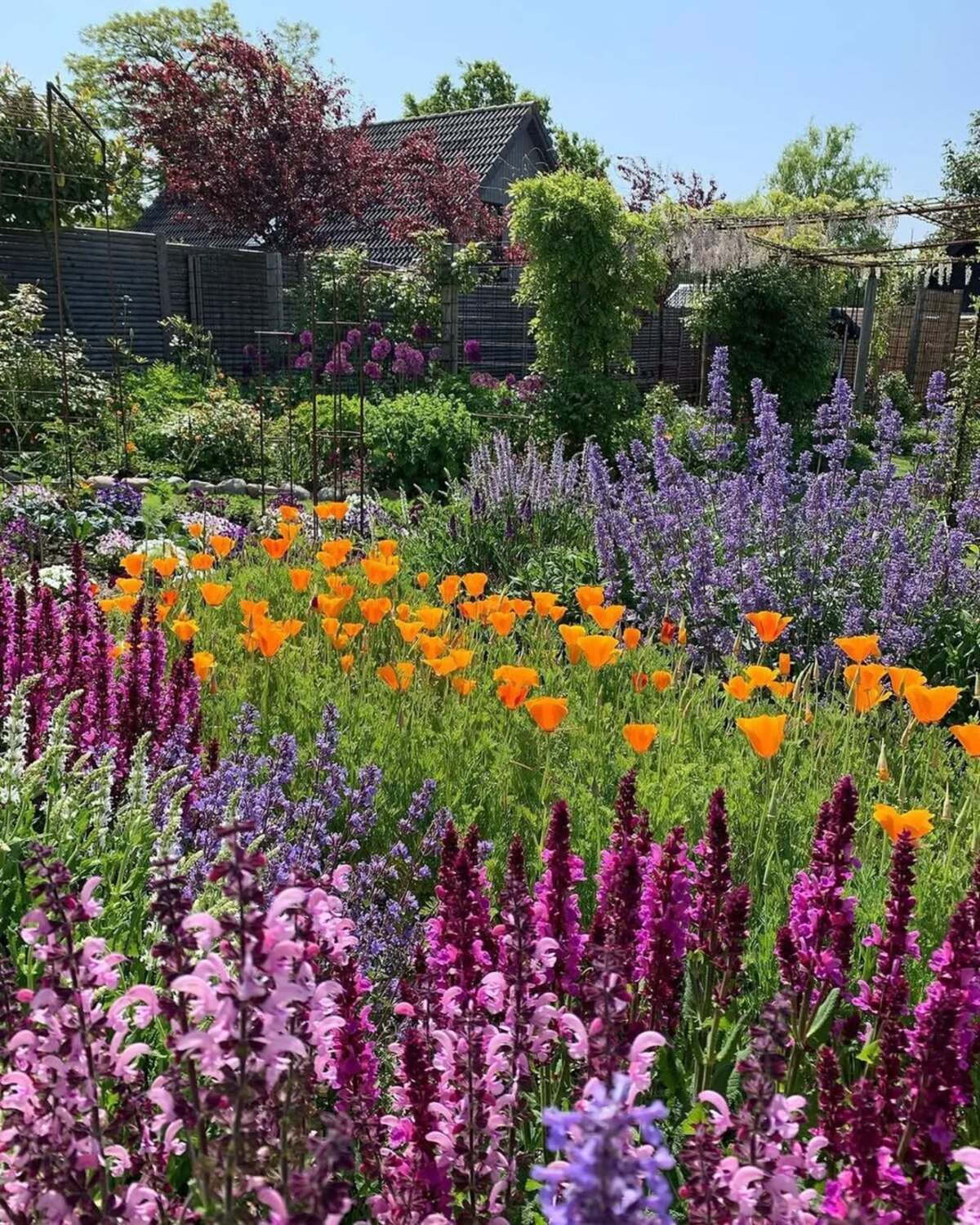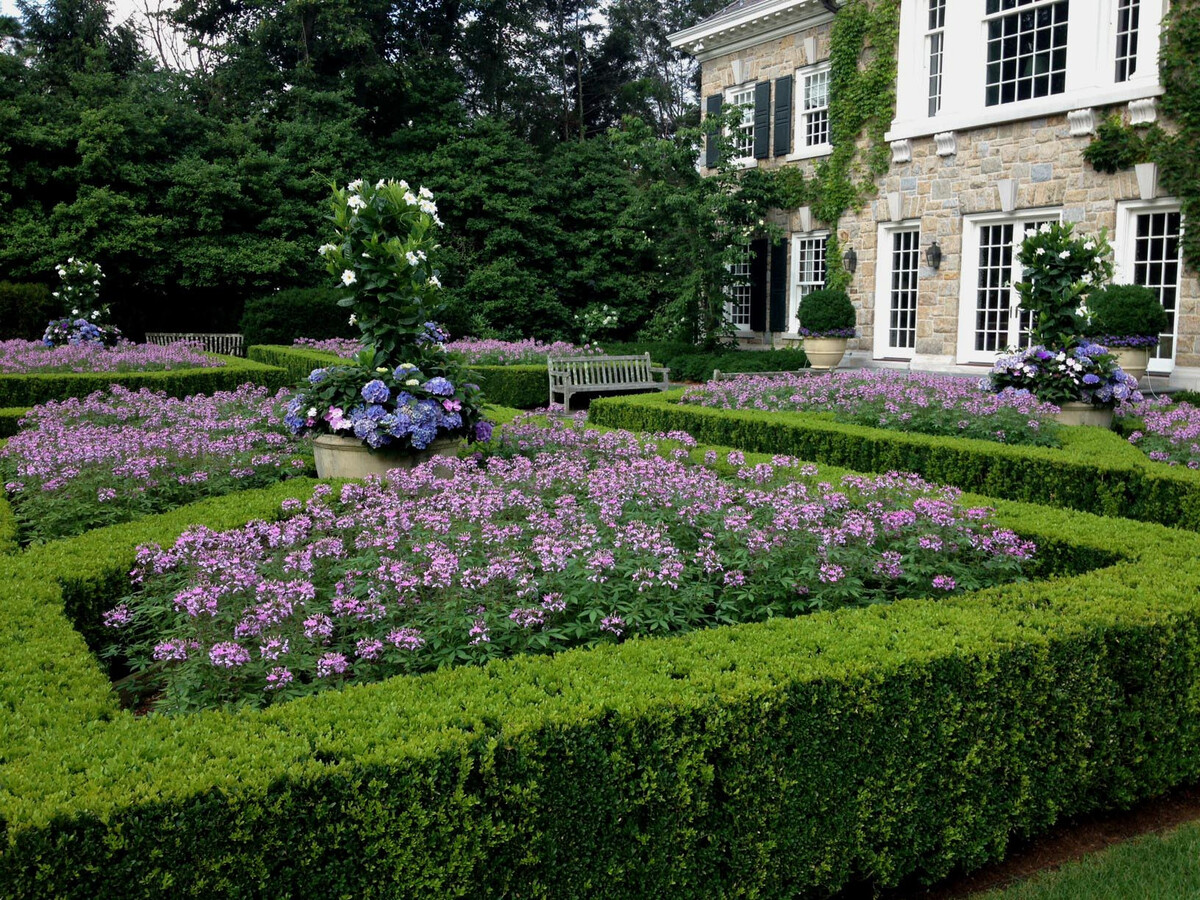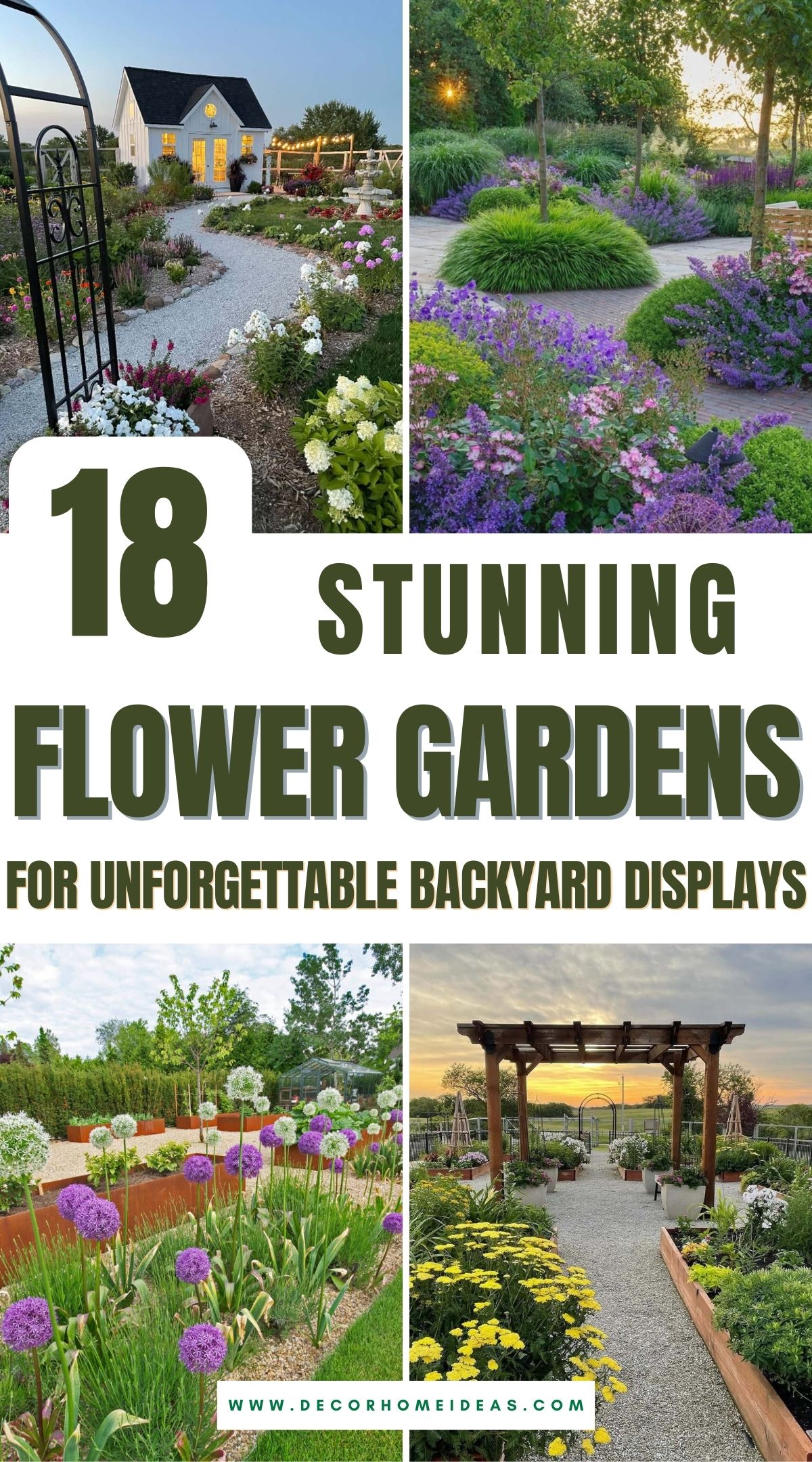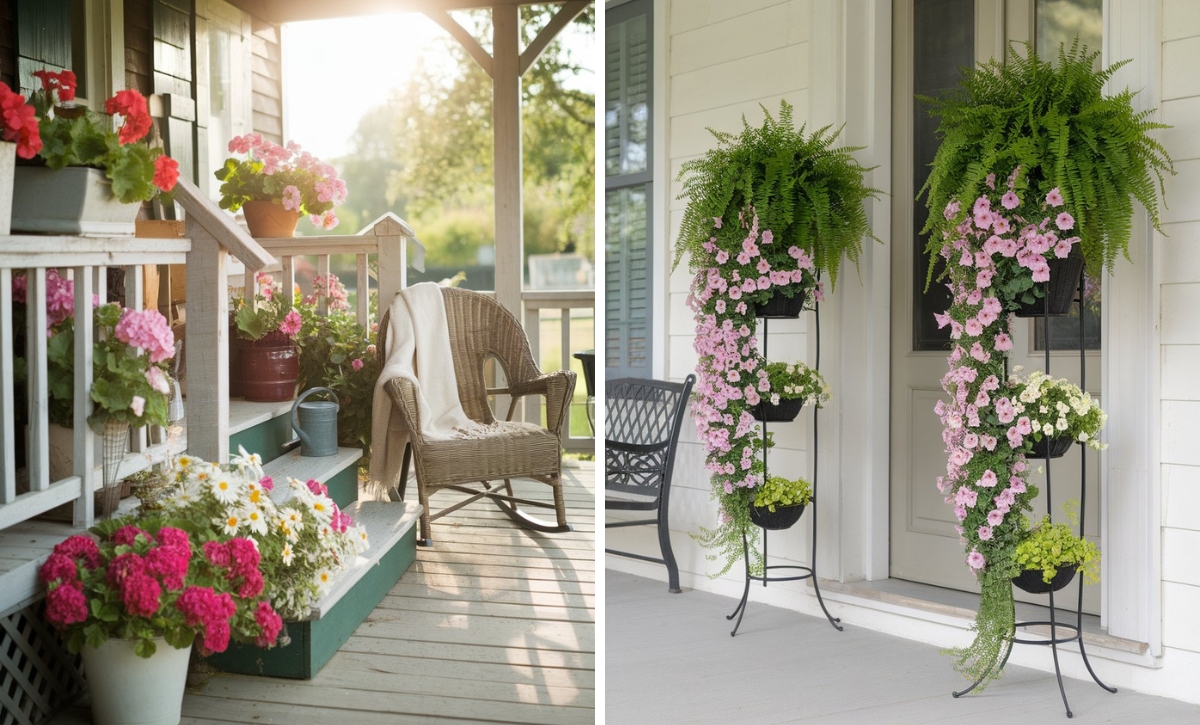Flower garden ideas are one of the best ways to add seasonal color to your outdoors.

It’s essential to choose the right flowers for your space, whether you plan to plant in the ground, raised beds, or container planters. It’s also best to consider what kind of light your space receives throughout the day to determine the best flowers for your garden.
Your soil type and PH conditions are also critical to your flower bed’s health and development, so remember to conduct a soil test to determine which nutrients are deficient in the planting medium.
We’ve compiled 18 bold and beautiful big flower gardens that will make your landscape more attractive and beckon you and visitors alike with blooms.
Take a look!
1. Uplift Your Farmhouse Facade

This glamorous front yard is filled with yellow, orange, red, pink, and white hydrangeas, chrysanthemums, and roses that add warmth and color to the stony pathway, farmhouse exterior, and lush green lawn.
2. Create a Border

A beautiful flower garden of tulips, asters, salvia, mums, and daisies hugs the border of a neatly manicured lawn in this elegant home.
The colorful, formal landscaping matches the villa’s refined setting with its potted and hanging planters.
3. Colorful and Bold

One way to reduce the chaos of a big flower garden is to use healthy shrubs and trees as the backbone of the garden.
Catnip, California poppies, and perennial sage fill this garden with contrasting colors that are pleasing to the eye.
4. Add some Mulch

Mulch is an excellent way to make the flowers in your garden pop. Here, brown mulch provides a great background for the seasonal flowers to take center stage and boost the curb appeal.
The colorful and generous flower garden is filled with snow-in-summer dianthus, sage, lavender, and ninebark trees, which make relaxing at the pool gratifying.
5. Adopt Raised Gardens

If you are growing vegetables in raised gardens, consider creating a potager garden by accenting your veggies with flowers to play up their symbiotic relationship.
Nectar-rich plantings, such as the flowering allium bulbs featured here, can attract pollinators who will swap pollen and hugely boost your vegetables’ productivity.
6. Walk In Serenity

The paved pathways in this outdoor garden are planted with a whimsical arrangement of flowers such as petunias and lavenders and plants like tall landscaping grasses that capture the movement and vibrancy of the borders, making them feel special.
7. Highlight Curves

This poolside flower garden uses perennial flowers like Helenium ‘Salsa’ and annuals such as Nicotiana sylvestris (flowering tobacco) to highlight the gentle curves of the lawn and draw the eye to the Scandinavian exterior.
8. Add Some Height

@Verdance Landscape Architecture
As long as your space is receiving enough sunlight, a flower garden is always an ideal option, not to mention easy to execute! Here, skinny evergreens like ‘Tiny Tower’ Italian cypress and a wall covered with creeping fig provide rhythmic structure to the bluestone entry walkway.
Various shrubs such as Viburnum davidii, Spiraea japonica, and Osmanthus fragrans combine with flowers like white tulips, Impatiens, pansies, and Francoa ramosa to create a soothing green and white palette that keeps the outdoor space feeling cool and lush.
9. Soften Your Landscape

@Caroline Benedict Smith Garden Designer Cheshire
Creeping flowering plants are an excellent option to add vibrancy to your hardy landscape. Here, a reclaimed York stone patio is softened by purple Phlox subulata and bright pink Crackerjack.
10. English Garden Style

Even though butterflies and hummingbirds appreciate bright colors, it’s also essential to incorporate flowering plants with shallow flowers that contain rich, easily accessible nectar stores.
The beautiful traditional architecture of the home featured in this idea inspired the organized chaos of an English garden in the front yard, with perennials providing pops of purple and pink to give the outdoor space a romantic feel.
11. Inspire with a Cottage Garden

Cottage gardening’s free-form nature provides the leeway to incorporate numerous classic flowers into your outdoors. Cottage garden designs are well-known for heirloom or fragrant cultivars such as hollyhocks, lavender, geraniums, and old English roses.
Repeat plant varieties throughout your path’s border or flower bed to ensure there’s a method to the madness, and stick to a simple color palette, like the white, pink, and red one in this garden.
12. Go for Raised Garden Beds

If you are an amateur gardener and want to keep things simple, DIY raised garden beds are an excellent solution.
Raised beds enable you to conduct your gardening in what may otherwise be unsuitable conditions like rocky, sandy, or heavy clay soil. A few concrete planters in this garden add height to the white and yellow blooms in the raised beds.
13. Define Borders

Hydrangeas and thalictrum infuse this backyard with beautiful colors, contributing a subtle interest to the flower garden that influences the space’s overall design.
The colorful flowers bordering the path define spaces against which to plant blooms of varying heights, giving the flower garden a sense of place.
14. Opt for a Wild Look

If deadheading and fertilizing seem a bit too much to undertake, consider going for a wildflower garden.
Here, exuberant hues of daylilies, dahlias, and gomphrena beckon bees and butterflies from a distance. A pergola in the center helps add a sense of height.
15. Introduce Planters

Every flower garden should include at least one container planter, especially if you are working with a small footprint.
The white and purple petunias in the bucket planter in this garden idea create a delightful contrast while complementing the vibrant hydrangeas nearby.
16. Conceal the Edge

@NatureWorks Landscape Services, Inc.
A multitude of green plants and a hand-spade-edged lawn pair with purple, pink, yellow, red, and white perennials and annuals like Cleome to provide this lush landscape an effortless and energizing feel.
17. Consider a Monotone Look

@Casa Architecture Interior Design
You don’t need a multi-colored flower garden to make a bold statement. Using a single color on a much larger scale will bring an outsize impact.
Here, two generous sections of white impatiens border a stony stairwell, echoing the modern farmhouse feel of the property.
18. Make it Formal

@Elizabeth Hand-Fry, Landscape Architect
A formal landscape provides a tidy layout and clean lines that are pleasing to the eye, but adding flowers is an excellent counterpoint to the neatly trimmed shrubs and lawns. Consider one or two flower cultivars with neat growing habits in order to best complement your scheme.
Purple Cleome has been used to fill up the middle of these hedges for a pristine landscape. Hydrangeas and clematis have also been used to great effect in the formal garden to add some interest and height.











